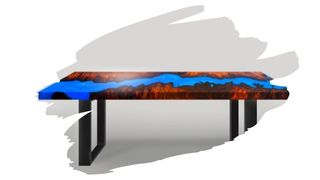It’s strong, it’s durable, and it is incredibly waterproof as well. All of which make epoxy one of the best ways to fill in cracks, and seal over wooden surfaces.
Now, this hardened material can be easily sanded smooth or drilled into. But, if you want a truly even surface, can you use a router to finish those epoxy edges too?
Well, in this post, you will find out the easiest way to flatten out epoxy resin. You will also learn why you must always wait for epoxy to cure (not simply dry) before you begin smoothing it out.

This post may contain affiliate links to products that we receive a commission for (at no additional cost to you). Learn more here.
What Tool Can You Use To Flatten Epoxy?
Your best option is to simply sand it down with an orbital sander.
Even basic manual sandpaper will take off a good amount of that epoxy resin material. What’s more, it is probably the cheapest and most cost effective method as well.
And, it is a quick and easy way to smooth out the surface. So, by going over epoxy with ever finer grit sandpaper, you can get an almost polished appearance.
Still, this works best if you are working on a flat surface. Yet, when it comes to those edges, getting them consistent can be a bit trickier.
What About A Router? Will A Router Work On Epoxy?
Absolutely, a hand router with the right bit, won’t have any trouble on epoxy.
And you should always wait for the epoxy to wholly cure all the way through first. Don’t use a router on epoxy that is still curing.
Related Post: The Best Wood Routers For Beginners
But How Do You Know When Epoxy Is Fully Cured?
Honestly, this is something that you simply learn with practice.
Epoxy takes around 1-2 days to dry. But, as a rule of thumb, epoxy can take up to three days (around 72 hours) to cure. And even then that depends more on the airflow, (and local climate), of the room it is sitting in.
Now, a still curing epoxy can appear ‘dry’ on the surface of it. And, at this drying stage, epoxy has the give of firm rubber.
But, if your fingernail can still make any kind of impression into epoxy, then it needs more time to cure.
What Happens If You Use A Router On Epoxy Before It’s Had Time To Cure?
If you handle, move, or otherwise work on still curing epoxy, you can end up contaminating the surface. This is called ‘substrate contamination’.
Substrate contamination refers to when epoxy ends up with lots of tiny holes all across it’s surface. And it is typically the result of dirt, dust, and grime getting into epoxy, before it’s had time to harden.
Related Post: Woodworking 101: What Does A Router Do Really?
So What Type Of Router Bit Do You Recommend For Epoxy Edges?
It depends on the type of final edge you are looking for. Still, if you want the kind of smooth edges that you typically find on furniture, then use a roundover bit.
These router bits are the ones you use when you want to get a smooth rounded edge on tables or drawers. And they’ll work equally well on epoxy resin as well.
To Wrap Up, Here Are The 3 Key Takeaways From This Post…
1). You can smooth out epoxy resin with an orbital sander or manual sandpaper.
2). You can also use a router on those epoxy edges too.
3). For a smooth rounded edge, use a roundover bit.
